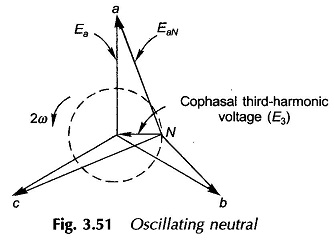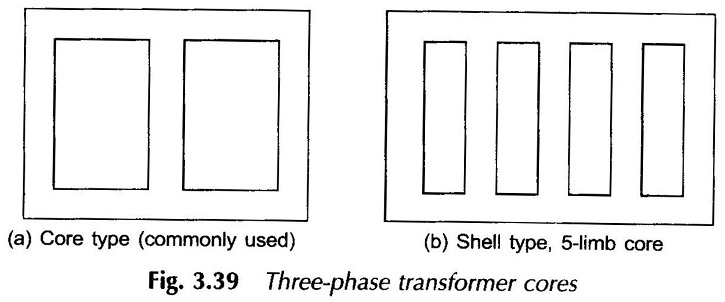Three phase Transformer Bank of Single phase Transformers:
The different Three phase Transformer Bank of Single phase Transformers are namely,
Delta/delta connection:
The supply voltage provides only sinusoidal magnetizing current so that core flux is flat-topped; but the third-harmonic emfs induced (cophasal) cause circulating currents in deltas restoring the flux to almost sinusoidal. The third-harmonic voltages are very small as the transformer offers low impedance to third-harmonic currents.
Star/delta and delta/star connection:
Because of one delta connection the same conditions are obtained as in Δ/Δ connection except that the impedance offered to the flow of third-harmonic currents in delta is now larger and so are third-harmonic voltages.
Star/star connection:
In the case of isolated neutrals, third-harmonic voltages are present in each phase as explained earlier. Further, since these voltages are cophasal, no third-harmonic voltages are present between lines. The voltage of phase a to neutral can now be expressed as
While fundamental frequency voltages in the three phases have a relative phase difference of 120°, the third-harmonic voltages in them are cophasal (with respect to each other), but their phase with respect to the fundamental frequency (voltage changes at the rate of 2ω, twice the fundamental frequency). This situation is illustrated in the phasor diagram of Fig. 3.51 from which it is immediately observed that the voltage of the neutral point oscillates at frequency 2ω. The phenomenon is known as oscillating neutral and is highly undesirable because of which the star/star connection with isolated neutrals is not used in practice.
If the neutrals are connected, it effectively separates the three transformers. Third-harmonic currents can now flow via the neutrals.
Three-phase Transformer:
In core type transformer (Fig. 3.39(a)), the third-harmonic fluxes in all the three limbs are simultaneously directed upwards or downwards so that this flux must return through air (high-reluctance path). The high-reluctance path tends to suppress the third-harmonic flux. The phenomenon gets more complex now and at core densities exceeding 1.5 T, the total harmonic content (particularly fifth) is very marked in the magnetizing current (fifth harmonic currents can flow on lines as their relative phase difference is 5 x 120 = 600° or 120°).
To reduce the strong fifth harmonic in the magnetizing current for the star/star connection with isolated neutral, a path must be provided through iron for the third-harmonic flux. Hence, the use of a 5-limb core as in Fig. 3.39(b).

